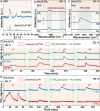Promoting Molecular Exchange on Rare-Earth Oxycarbonate Surfaces to Catalyze the Water-Gas Shift Reaction
- PMID: 36657461
- PMCID: PMC9896556
- DOI: 10.1021/jacs.2c10326
Promoting Molecular Exchange on Rare-Earth Oxycarbonate Surfaces to Catalyze the Water-Gas Shift Reaction
Abstract
It is highly desirable to fabricate an accessible catalyst surface that can efficiently activate reactants and desorb products to promote the local surface reaction equilibrium in heterogeneous catalysis. Herein, rare-earth oxycarbonates (Ln2O2CO3, where Ln = La and Sm), which have molecular-exchangeable (H2O and CO2) surface structures according to the ordered layered arrangement of Ln2O22+ and CO32- ions, are unearthed. On this basis, a series of Ln2O2CO3-supported Cu catalysts are prepared through the deposition precipitation method, which provides excellent catalytic activity and stability for the water-gas shift (WGS) reaction. Density functional theory calculations combined with systematic experimental characterizations verify that H2O spontaneously dissociates on the surface of Ln2O2CO3 to form hydroxyl by eliminating the carbonate through the release of CO2. This interchange efficiently promotes the WGS reaction equilibrium shift on the local surface and prevents the carbonate accumulation from hindering the active sites. The discovery of the unique layered structure provides a so-called "self-cleaning" active surface for the WGS reaction and opens new perspectives about the application of rare-earth oxycarbonate nanomaterials in C1 chemistry.
Conflict of interest statement
The authors declare no competing financial interest.
Figures





Similar articles
-
Chemoresistive CO2 Gas Sensors Based On La2O2CO3: Sensing Mechanism Insights Provided by Operando Characterization.ACS Sens. 2020 Aug 28;5(8):2555-2562. doi: 10.1021/acssensors.0c00882. Epub 2020 Aug 19. ACS Sens. 2020. PMID: 32786387
-
A new approach to synthesis of layered fluorites containing molecular anions: synthesis of Ln2O2CO3, K(LnO)CO3, and Ln2O2CrO4 via metathesis reactions.Inorg Chem. 2008 Apr 21;47(8):3065-71. doi: 10.1021/ic701558m. Inorg Chem. 2008. PMID: 18355050
-
Unique properties of ceria nanoparticles supported on metals: novel inverse ceria/copper catalysts for CO oxidation and the water-gas shift reaction.Acc Chem Res. 2013 Aug 20;46(8):1702-11. doi: 10.1021/ar300231p. Epub 2013 Jan 3. Acc Chem Res. 2013. PMID: 23286528
-
Gold catalysts for pure hydrogen production in the water-gas shift reaction: activity, structure and reaction mechanism.Phys Chem Chem Phys. 2006 Dec 21;8(47):5483-500. doi: 10.1039/b607837k. Epub 2006 Oct 2. Phys Chem Chem Phys. 2006. PMID: 17136264 Review.
-
Theoretical Calculations on Metal Catalysts Toward Water-Gas Shift Reaction: a Review.Chemistry. 2023 Apr 25;29(24):e202203781. doi: 10.1002/chem.202203781. Epub 2023 Mar 20. Chemistry. 2023. PMID: 36723438 Review.
Cited by
-
Tunning valence state of cobalt centers in Cu/Co-CoO1-x for significantly boosting water-gas shift reaction.Nat Commun. 2025 Jan 16;16(1):736. doi: 10.1038/s41467-025-56161-w. Nat Commun. 2025. PMID: 39820052 Free PMC article.
-
The reverse water gas shift reaction (RWGS) mechanism study on the γ-MoC(100) surface.RSC Adv. 2025 Jan 3;15(1):460-466. doi: 10.1039/d4ra08671f. eCollection 2025 Jan 2. RSC Adv. 2025. PMID: 39758931 Free PMC article.
-
Synthesis of defect-rich La2O2CO3 supports for enhanced CO2-to-methanol conversion efficiency.Sci Adv. 2024 Dec 6;10(49):eadr3332. doi: 10.1126/sciadv.adr3332. Epub 2024 Dec 4. Sci Adv. 2024. PMID: 39630897 Free PMC article.
References
-
- Tsai C. H.; Chen H. T.; Althaus S. M.; Mao K.; Kobayashi T.; Pruski M.; Lin V. S. Y. Rational Catalyst Design: A Multifunctional Mesoporous Silica Catalyst for Shifting the Reaction Equilibrium by Removal of Byproduct. ACS Catal. 2011, 1, 729–732. 10.1021/cs200222t. - DOI
-
- Wei L. Y.; Azad H.; Haije W.; Grenman H.; de Jong W. Pure methane from CO2 hydrogenation using a sorption enhanced process with catalyst/zeolite bifunctional materials. Appl. Catal. B: Environ. 2021, 297, 120399.10.1016/j.apcatb.2021.120399. - DOI
-
- Huang W. J.; Yu C. T.; Sheu W. J.; Chen Y. C. The effect of non-uniform temperature on the sorption-enhanced steam methane reforming in a tubular fixed-bed reactor. Int. J. Hydrogen Energ. 2021, 46, 16522–16533. 10.1016/j.ijhydene.2020.07.182. - DOI
-
- Wang H.; Wang L.; Lin D.; Feng X.; Niu Y. M.; Zhang B. S.; Xiao F. S. Strong metal–support interactions on gold nanoparticle catalysts achieved through Le Chatelier’s principle. Nat. Catal. 2021, 4, 418–424. 10.1038/s41929-021-00611-3. - DOI
LinkOut - more resources
Full Text Sources

